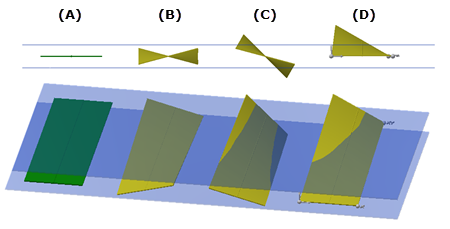Twist
A rotation of a portion of the part relative to another portion of the part, creates a Twist in the part.
In the following figure, there are three examples of a part that is twisted (yellow parts) compared to the original part (green). The warpage tolerance defined as +/- 5.0 mm from a defined datum. The top half of the figure is a front view, and the bottom half shows the parts as rotated. The three twisted parts are the same. The difference between them is how they relate to the +/- 5.0-mm tolerance.
The green part on the left (A) is the base part and is perfectly flat, in the XY plane, and is what the part should be. The second part from the left (B) has a symmetric twist and is shown with best fit. This second part appears to be in tolerance. A Z-deflection plot is used to determine flatness in this case.
The third part from the left (C) has a twist that is asymmetric relative to the XY plane. Even though the amount of twist is the same as the part to its left, it is out of tolerance. If, however, a 10-mm geometric tolerance was used, the asymmetrically twisted part would be in tolerance. The geometric flatness tolerance is not related to any orthogonal plane.
The part on the right (D) has anchors in three corners, making the fourth corner move high in the Z-direction well above the +/- 5.0-mm tolerance. Using three anchors for determining flatness is typically not a good idea. If the maximum Z-deflection using three corner anchors is under the tolerance, you know that the part is OK. In this case, using three anchors suggests the part is not in tolerance. If, however, the three anchors represented assembly locations, then using anchors in the corner is the best way to review the deflection.
The twisted example shows it is critical to understand:
- How warpage tolerances are being applied.
- How parts are being measured for warpage.
No single method of reviewing warpage works in all situations.

A = Original part
B = Part with symmetric twist and best fit
C = Part with Asymmetric twist and best fit
D = Part anchored in 3 corners
Blue planes represent the tolerance
